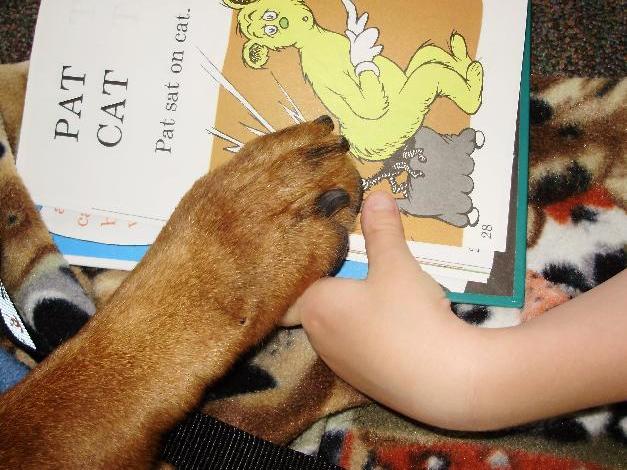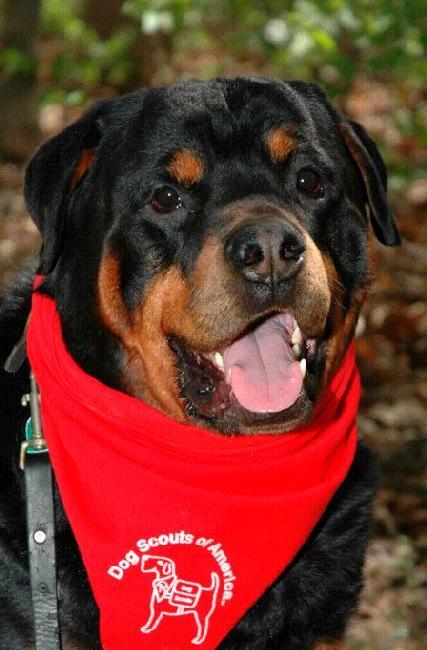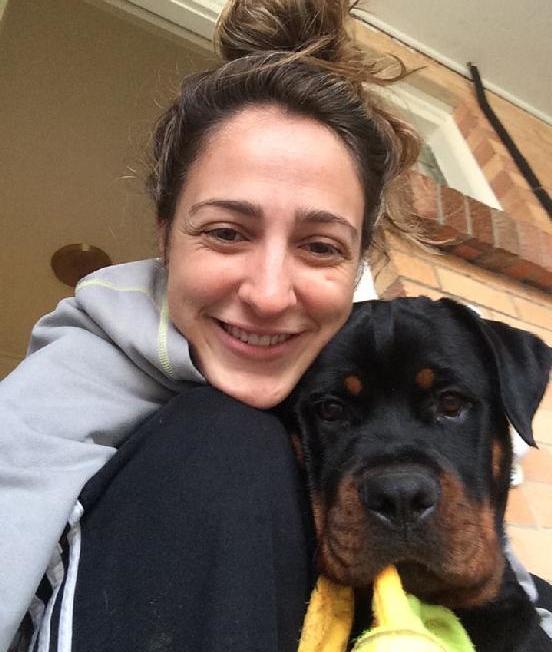
12 minute read
Drop” cue early on is essential
c a n i n e The Dog Who Changed Everything
Heddie Leger relates the tale of Hero, the Rottweiler who lost his guardian, and who was rescued and went on to have an inspirational new life as a much loved therapy dog and prison program dog
Advertisement
© Heddie Leger Rottweiler Hero was an atrisk puppy at birth and the veterinarian did not expect him to survive

© Heddie Leger Author Heddie Leger and her therapy dog, Hero, began the first reading programs with the MidContinent Public Library and the Kansas City Public Library systems
“Scary times, and yet I keep trying to find the peace that is everywhere; if I can calm my mind and simply be. The net of kindness and love has been torn, and yet, still enough strands remain to carry us on.” (S. Clothier, personal communication, 2020).
Iopen this article with these thoughts so aptly shared by a wonderful paragraphs, but space and time dictate these parameters. soul friend and trainer, Suzanne Clothier. These words graciously Hero was an atrisk puppy at birth. The veterinarian did not expect summarize a vast ocean of emotions we across the globe currently him to survive, yet somehow he did. He loved to sit by his first are experiencing. We will carry on because we must. guardian’s side 24 hours a day. They were totally bonded, but, sadly, one
This could also be the life mantra of a very special canine that I had day the dreaded cancer took her from him and he was left homeless. At the good fortune to cross paths with on my life journey as an animal the shelter, he sat in a kennel waiting for someone to love him, but 100lover, rehabilitator, rescuer and trainer. When we work in the field of an pound Rottweilers often have difficulty finding new homes. I decided to imal sheltering and training we come across many dogs, all special in bring him home for an overnight to give him a break from the kennel. their own unique way. However, every once in a blue moon someone He laid down in the middle of the living room and claimed our home comes along who you recognize as your soul dog. The dog that changes and hearts as his own. He never left either of them. everything about your life and how you live. With a heart as big as Texas, soulful eyes, kindness, wisdom, calmness and a friendly spirit, Hero walked among people as if he knew and Soul Dog understood each one of them. He would adapt his behavior to each perEnter Hero! It will be a challenge to encapsulate Hero in a few short son or dog he met, making friends across the world. We can train the skills for dogs to become therapy and/or service Enter Hero. This big, burly dog certainly got the attention and respect of the offenders we dogs, but it is very important to look at the individual to see what it is they want to do and/or were born to do. It was very clear Hero wanted to be a therapy dog, so that is exactly what we did…..together. He beworked with. The bonus of this was that I also came officially registered and served his entire life, including the day he received their respect, because who would mess passed. He LOVED his job. with a little lady who could skillfully Hero gained love, admiration and respect everywhere he went. He manage a 100+ pound Rottweiler? brought a healing touch to hospice patients as well as many people who had mental or behavioral challenges. He was so admired for his work
that Purina officials dubbed him Pet Partner of the year and honored him with a coveted personal brick at the Fountain of Friends at their St. Louis headquarters in Missouri. But that is not all.
Prison Dog Program
I had read about prison dog programs and had been intrigued. One day, the director of the Missouri Corrections Department sent out a notice announcing that they were looking for dog trainers to help develop a training program. I went to the meeting. The room was full of trainers from across the state. I knew in my heart of hearts this was my calling, but time would tell.
The meeting turned in to two meetings. Only a handful of people showed up for the second meeting as it focused more on the nitty gritty, so to speak. At the third meeting, only two people showed up – me and one other lady. It was daunting, but I felt driven to help in this area of service to the community.
My first assignment was in a residential treatment facility that actually looked like a hospital. I found out that a high percentage of residents were dealing either with some form of mental illness or with drug addiction and were in this particular facility for rehabilitation.
Enter Hero. This big, burly dog certainly got the attention and respect of the offenders we worked with. The bonus of this was that I also received their respect, because who would mess with a little lady who could skillfully manage a 100+ pound Rottweiler?
Our classes took place anywhere we could squeeze out some space. While these facilities are sometimes lacking in the finer amenities, we managed to make it work. Sometimes we even taught in housing units when there was no place else to go.
Zero Tolerance
Requirements to be part of the program were and still are very stringent. There is zero tolerance for any behavior that is not kind or respectful. Raised voices, as well as any form of physical or verbal abuse are not accepted. Only forcefree training methods are taught and permitted. The project started initially with two facilities and, in several short years, grew to 20 facilities.
Anyone selected to work with the dogs must be infraction free for one year. It is a great incentive for good behavior, so fits very well in the category of rehabilitation. Those interviewed and selected must go through a conflict management, decision making, team player, and train the trainer program before being allowed to handle a dog from the shelter. The dogs are carefully selected to give as many atrisk dogs as possible the chance to get the socialization and training needed to help them become highly adoptable.
At first, the state director mandated that no pit bull or pit bulltype dogs would be allowed. Enter Hero once again. Hero to the rescue! We set up a staff training program using Hero as the demo dog so he could show wardens and staff that dogs such as Rottweilers can also be wellmannered. They learned that it is the deed, not the breed, that really matters. The first pit bulls were then permitted to join the program, under strict guidance. Now, across the state you can see a good percentage of the dogs in training are pit bull or pit bull crosses. And, on the Missouri Department of Corrections website, you can see all the newsletter updates, the training protocols developed (some may vary), and details about the successful adoptions of thousands of shelter dogs through the Puppies for Parole program.
Community
As the program developed, participants who reached their release dates often went into the field of animal care. Some worked for major box stores, local grooming shops, or shelters, and some even started their own businesses serving the community. We also developed advanced training for dogs that showed a propensity towards a working career.

Therapy dog Hero: While we can train the skills for dogs to become therapy and/or service dogs, it is also essential to look at the individual to see what it is they want to do and/or have a propensity for
© Heddie Leger
The program trained the very first courthouse dog that helped children of abuse testify in court.
In addition to the dog training, the program is also intended to be a way for offenders to rehabilitate, give back, and learn how to reintegrate into the community. Skills that many had never developed, including reading and writing, form a strong core basis. We have heard it said many times from trainers in the program that, “If I knew then, what I know now, I would not be here.” Many participants learned how to read and gained a GED as another positive result of the training program, as they wanted to be able to read the manuals.
One often overlooked side effect regarding people who are incarcerated is the undeniable fact that many have family, children and support systems outside the walls of the prison.
The ripple effect of these broken lives often compounds over generations. When I realized this, I found it imperative to address this issue. I spoke with social workers that worked with the offenders and we came up with a novel idea to create a program for children of incarcerated parents. The program allowed for stronger bonds and learning experiences for those in the prisoner’s support system. The hope was to break the cycle.
We created handson activities and exercises for the children of offenders that could be implemented in real life. One such activity was designed to develop leadership and teamwork skills.
This particular activity included one dog, four children, and one adult supervisor. Children were first required to attend a pet safety and bite prevention class.
Helping Children
For these classes, Hero would wear a harness with six leashes attached. Each child, as well as the supervisor, held a leash. Children learned how to lead, give directions, follow directions, manage their behavior and reactions, and make good choices by being the decision maker for the team.
The leader would call the cue word for the action desired such as ‘sit,’ ‘down,’ ‘left turn,’ ‘right turn,’ etc. As the dog performed the de
sired cue, each child had to do the same thing. So, if the dog sat, each child had to sit, lay down, etc. Each child had the opportunity to lead and follow by being part of the team.
This turned into the social workers’ favorite activity since they saw so many beneficial results. The children were asked for their feedback and 100% reported that it helped them learn how to work together, listen, wait their turn, follow directions and a host of other beneficial social skills. Not only that, offenders reported it strengthened and, in some cases, rehabilitated the family structure.
International Reach
Meanwhile, we set up a statewide apprenticeship program for Puppies for Parole. It required a minimum of 2,000 handling hours, plus other stringent requirements. The Department of Labor now recognizes this apprenticeship program along with other education and life enhancing programs in the rehabilitation process for offenders.
Several years ago, a contingent of folks visited from Battersea Dogs & Cats Home in London, England in order to learn how to implement a similar program under their rehabilitation of animals and humans programming. They were very pleased and impressed and returned home armed with mountains of information and inspiration. Missouri Puppies for Parole has since been a model for many developing programs across the country.
During these uncertain times, sadly, many of the prison dog programs have been shut down across the country due to safety, security and health concerns. Fortunately, the Missouri Puppies for Parole program is going strong in most of its facilities. They are still serving the community, working with local shelters, and adopting out dogs on a daily basis, that might not otherwise have had a second chance at life.

ANIMAL COURSES DIRECT
As the program developed, participants who reached their release date often went into the field of animal care. Some worked for major box stores, local grooming shops, or shelters, and some even started their own businesses serving the community. We also developed advanced training for dogs that showed a propensity towards a working career. The program trained the very first courthouse dog that helped children of abuse testify in court.
This was completely intentional. The goal from the outset was to set up a selfsustaining program that could survive the ups and downs of the life cycle of any system, plus societal changes. I worked very hard on a daily basis to be in contact with each staff person involved at each facility. We set up quarterly training sessions with staff so they also had the skill set, should an emergency arise, to be able to carry on. Many have also become CPDT trained staff and/or joined other educational networks in order to keep their skills updated and network with trainers outside the corrections system.
I will close in saying the future of prison dog programs continues to look good. It is more challenging with the COVID restrictions, but people are finding a way to make it work and still save more lives. In addition, this world within a world, has found a way to touch lives beyond the prison walls. In many instances it has become a viable resource for shelters that were having difficulty adopting out atrisk dogs. It continues to be a winwinwin for all involved.
A small army of hidden heroes continues to work in the unseemliest of places to save lives. It is even more important, now than ever, for each of us to realize that any kindness extended to others can and does indeed change the world. Kindness matters. n
Don’t miss the inspiring story of Shawn Dowling, the newest recruit and dog trainer at the Northeast Missouri Humane Society. Shawn is a re‐cent graduate of the Puppies for Parole program and is an incredible testament to the success of the program.
Resources
Missouri Department of Corrections/Puppies for Parole
Heddie Leger is the owner/founder of Hero’s Hope and training coach with CampGoodStay in Camden, Tennessee, a full service canine coaching and pet care service. She is a certified humane educator, a therapy animal/instructor/evaluator, C.L.A.S.S. instructor/evaluator and CGC evaluator. Her passion of rehabilitating homeless and displaced dogs blossomed with her therapy dog, Hero, and developed into a full service program for rehabilitation of shelter dogs and correctional facility and people incarcerated in correctional facilities. Together, they received the Pet Partner finalist of the year, and Purina Service Team of the year award. She has worked in a collaborative effort with the Missouri Department of Corrections and local shelter/rescue groups to help facilitate a program that received the Governor’s Award for Innovative Programs. She was recently awarded the Director’s Coin of Excellence. She and her therapy dog, Hero, began the first reading programs with the Mid-Continent Public Library and the Kansas City Public Library systems. Those programs are still operating, as well as programs in the Liberty Public School District promoting literacy, humane treatment of animals and the importance of reading as a life skill. She is also a published author in several magazines as well as her book Hero to the Rescue, The Memoir of an Unlikely Hero.










